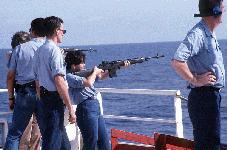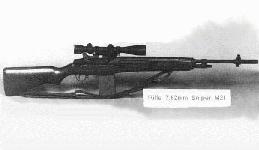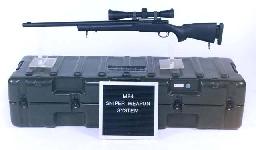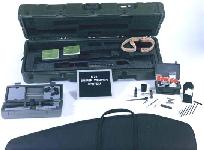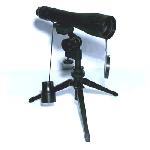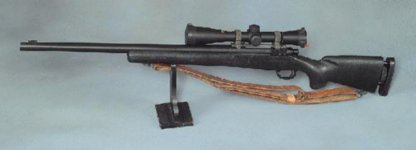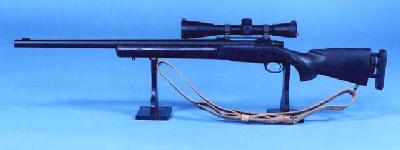 Seeking
a lightweight replacement for the M1 Garand and the
M1918A2 BAR, The Army selected the M14 rifle in 1957. Production
of the M14 rifle was halted in 1964, by which time 1,380,874 had been manufactured. The M14 7.62 mm rifle is a magazine-fed, gas operated shoulder weapon, designed primarily for semi-automatic fire. It was the standard service rifle until it was replaced in the late-1960s by the 5.56mm M16A1 rifle. At one time the standard issued rifle for Marines, the M14 is now used primarily in the Competition in Arms program, or for drill and ceremonial purposes. The M16 replaced the M14 as the Table of Organization rifle for the Marine Corps during the Vietnam War.
Seeking
a lightweight replacement for the M1 Garand and the
M1918A2 BAR, The Army selected the M14 rifle in 1957. Production
of the M14 rifle was halted in 1964, by which time 1,380,874 had been manufactured. The M14 7.62 mm rifle is a magazine-fed, gas operated shoulder weapon, designed primarily for semi-automatic fire. It was the standard service rifle until it was replaced in the late-1960s by the 5.56mm M16A1 rifle. At one time the standard issued rifle for Marines, the M14 is now used primarily in the Competition in Arms program, or for drill and ceremonial purposes. The M16 replaced the M14 as the Table of Organization rifle for the Marine Corps during the Vietnam War.
- M14, basically a product improved M1 Garand, performed well as a infantry rifle. The M14 had an effective range of 500 yards (460m). The M14 used a standard NATO 7.62mm cartridge in a 20-round magazine. The M14 was the standard Army infantry rifle, until replaced by the mass fielding of the M16 5.56mm rifle in 1966-1967. Some M14s were equipped with a bipod for use as a squad automatic weapons. However, the M14 displayed an erratic dispersion pattern, excessive recoil, and muzzle climb when fired as an automatic rifle.
- M14A1. The Army designed the model M14A1 to overcome
these problems, but it was too light to become a truly successful
replacement for the M1918 series BAR, and production was halted
in 1963. The M14A1 featured a full pistol grip and a folding
forward hand grip.
- M14 National Match (1959) was used in the semi-automatic mode only. The M14NM had special sight parts and barrels selected especially for accuracy.
The XM21 Sniper Rifle was developed jointly by the Army Weapons Command (Rock Island, IL), Combat Development Command (Ft. Benning, Ga), and the Limited Warfare Agency (Aberdeen, MD). The XM21 was an accurized M14 National Match (NM) semi-automatic rifle equipped with a Leatherwood 3X-9X Adjustable Ranging Telescope (ART). The Rock Island Arsenal converted 1,435 M14NM rifles to XM21 sniper rifles for initial fielding to Vietnam in 1969. The rifle was initially fielded with a hardwood stock, which was later replaced with a fiberglass stock. The XM21 was officially type classified M21 in 1975, though it had been informally called the M21 since December 1969. It was the primary Army sniper rifle of the Vietnam war and remained standard until replaced by the bolt-action M24 Sniper Weapon System beginning in 1988. The M21 was accurate to 750 yards (690m). The rifle used U.S. match grade M118 NATO 7.62mm cartridges, in five-round or 20-round magazines. The ART telescope featured a variable magnification power of from 3X to 9X, for adjustable ranging between 300m and 900m. This adjustable ranging feature removed much of the guesswork from aiming at the target. The ART was ballistically matched with U.S. M118 NATO ammunition (1,800).
The M24 Sniper Weapon System, fielded in 1988, represents a return to bolt action sniper rifles by the US Army. As in the US Marine M40A1, the M24 uses the Remington 700 receiver group, although the reciever has been made for adaptation to take the .300 Winchester Magnum round. The stock (HS Precision) is made of a composite of Kevlar, graphite and fibreglass bound together with epoxy resins, and features an aluminium bedding block and adjustable butt plate. A detachable bipod can be attached to the stocks fore-end. The M24 is equipped with a 10X fixed Leupold M3 Ultra telescope.
Length: 44.14 inches (112.12 centimeters)Length of Barrel: 22 inches (55.88 centimeters)
Weight:
Empty magazine: 8.7 pounds (3.95 kilograms)
Full magazine and sling: 11.0 pounds (5.0 kilograms)
Bore diameter: 7.62mm
Maximum effective range: 1,509.26 feet (460 meters)
Muzzle velocity: 2,800 feet (853 meters) per second
Cyclic rate of fire: 750 rounds per minute
Magazine capacity: 20 rounds
Unit Replacement Cost: $576






